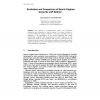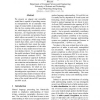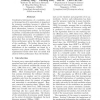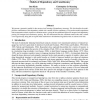GEOINFO
2004
15 years 2 months ago
2004
: This paper presents a model of data for mobile objects. The model is represented by spatial-temporal classes with mobility aspects, and represents the route and the trajectories ...
FORTE
2004
15 years 2 months ago
2004
In this paper, we present an approach for modeling an existing web application using communicating finite automata model based on the userdefined properties to be validated. We ela...
113
click to vote
FLAIRS
2004
15 years 2 months ago
2004
In our prior work, we introduced a generalization of the multiple-instance learning (MIL) model in which a bag's label is not based on a single instance's proximity to a...
CSC
2006
15 years 2 months ago
2006
CMG
2006
15 years 2 months ago
2006
We present a comprehensive model for quantitative evaluation and comparison of search engines. The model is based on the LSP method for system evaluation. The basic contribution of...
AIA
2006
15 years 2 months ago
2006
This paper presents a study of the model of triple BAM by [11] which is an improved variation of the original BAM model by [7]. This class of model aims at integrating different s...
106
click to vote
ACL
2006
15 years 2 months ago
2006
We present an elegant and extensible model that is capable of providing semantic interpretations for an unusually wide range of textual tables in documents. Unlike the few existin...
101
click to vote
ACL
2004
15 years 2 months ago
2004
Coreferential information of a candidate, such as the properties of its antecedents, is important for pronoun resolution because it reflects the salience of the candidate in the l...
ACL
2004
15 years 2 months ago
2004
We present a generative model for the unsupervised learning of dependency structures. We also describe the multiplicative combination of this dependency model with a model of line...
113
click to vote
AAAI
2004
15 years 2 months ago
2004
Plan recognition has traditionally been developed for logically encoded application domains with a focus on logical reasoning. In this paper, we present an integrated plan-recogni...




